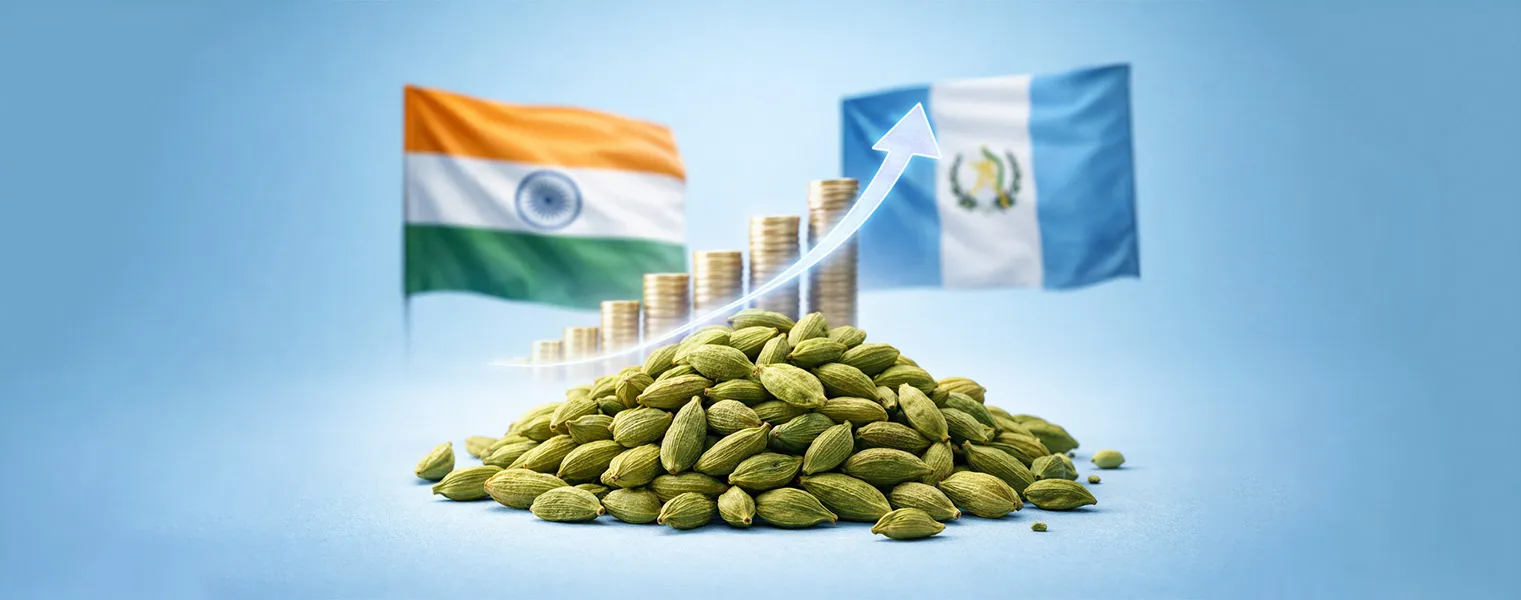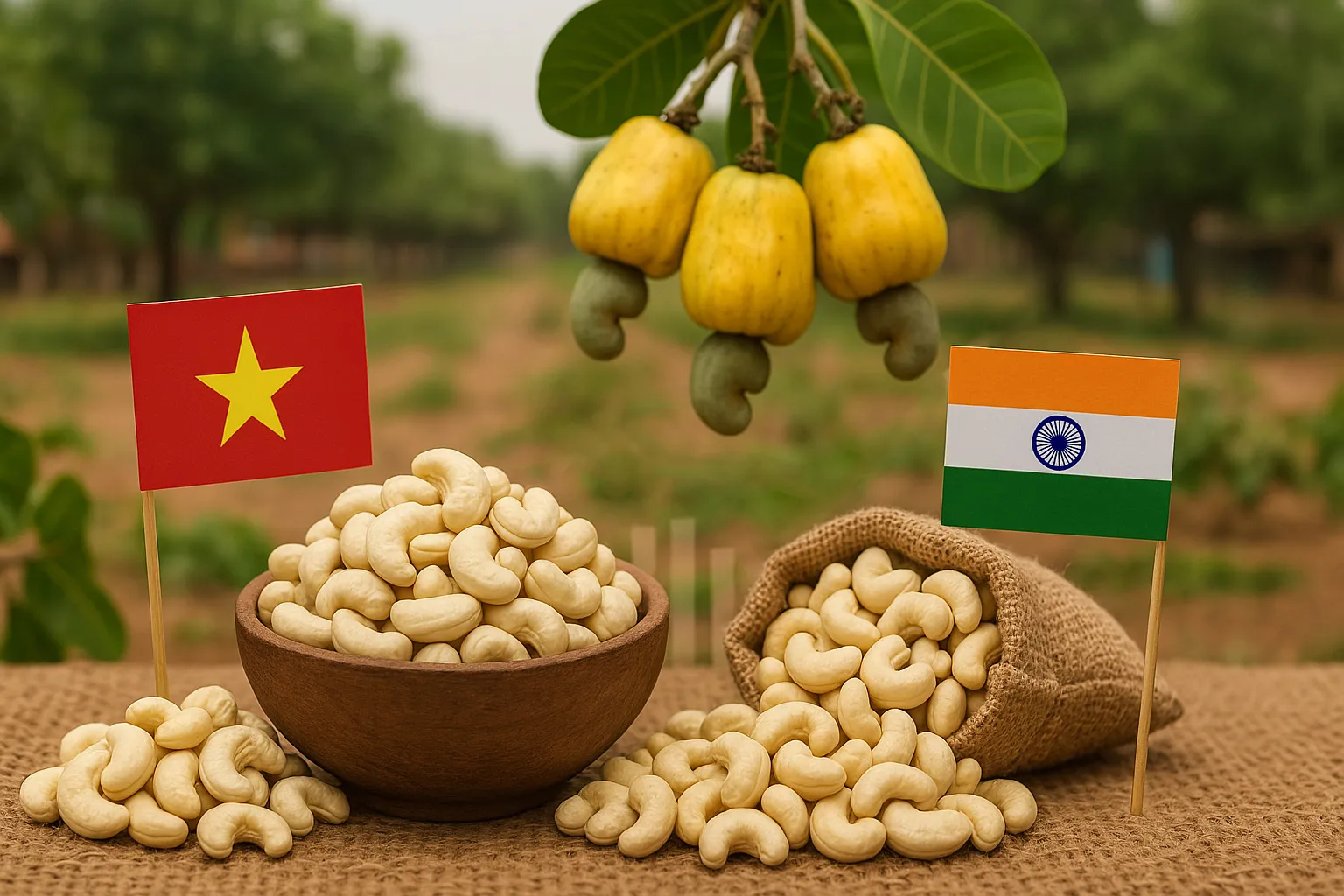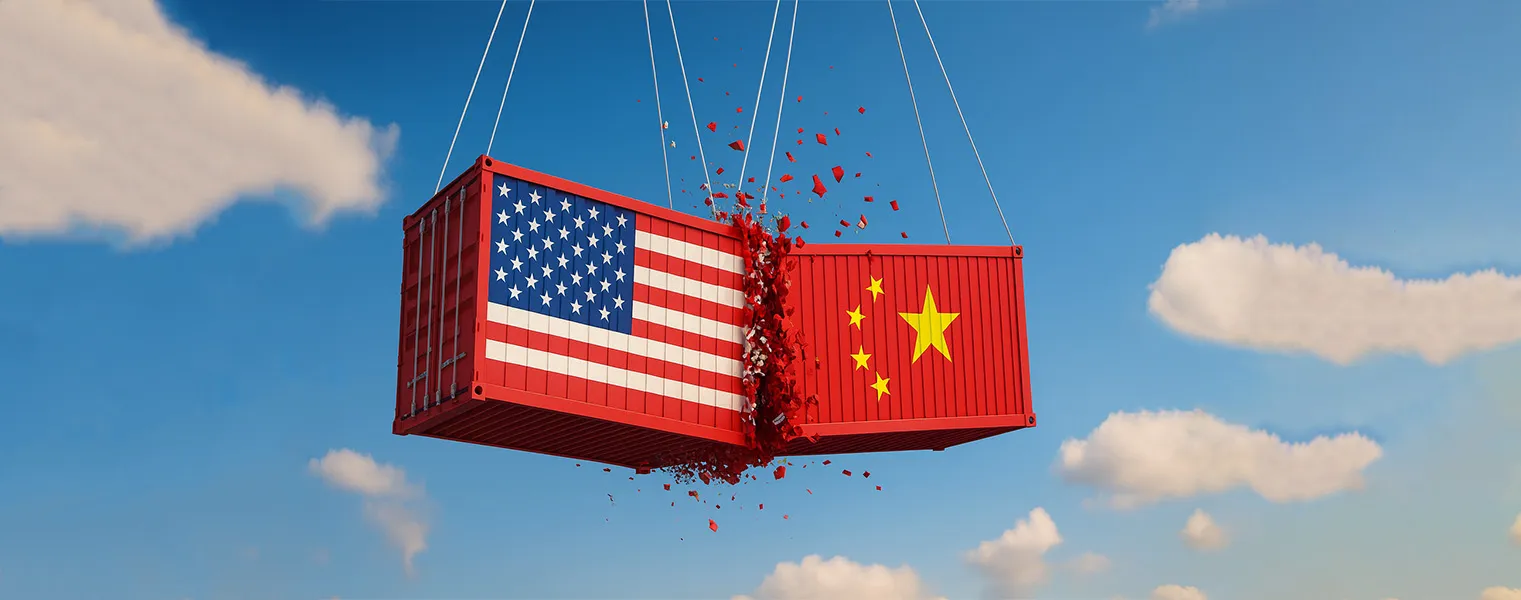Indian vs. Vietnamese Cashews: How Tariffs and Record EU Demand are Reshaping the Global Market!
In 2025, the global cashew market is witnessing transformative changes marked by record import figures in Europe, evolving trade policies, and dynamic shifts in production and supply. Major players like Vietnam, Ivory Coast, and India are navigating complex market conditions amid changing consumer preferences, production fluctuations, and critical tariff challenges—including a potential 46% levy on Vietnamese cashews. This comprehensive report dives deep into the latest updates, global production status, export–import trends, product quality, harvest timings, pricing movements, and future market signals affecting the cashew industry.
Latest Market Updates & News
Record EU Imports Drive Cashew Surge
EU cashew nut imports surged to a record 42,850 metric tonnes in the first quarter of 2025, reaching a value of EUR 273 million (approximately USD 300 million). This represents a 16% volume increase and a staggering 42% value increase compared to Q1 2024, when the EU imported 37,054 metric tonnes valued at EUR 193 million (USD 212 million).
- Key Insight: Vietnam dominates these imports, accounting for 72% of the EU’s cashew nut supply.
- Tariff Implications: Speculation is rife about the impact of a 46% US tariff on cashews from Vietnam. Since the US already represents more than 30% of Vietnam’s export market, traders and suppliers anticipate that heightened tariffs will force Vietnamese exporters to shift focus toward alternative markets such as the EU, Japan, and the Middle East.
Shifting Regional Dynamics
Alongside Vietnam, Ivory Coast has shown remarkable growth, with its cashew exports to the EU surging by 43%. Ivory Coast’s production estimates for raw cashew nuts now range between 1.2–1.4 million metric tonnes, up from 1.2 million tonnes last year, though farmers are now experiencing a drop in farmgate prices due to increased arrivals. India, the third largest supplier to the EU, saw a more modest export volume rise of 8%, even as quotations for W320 kernels have risen sharply since early March due to domestic price pressures and limited production capacity.

Global Production Status & Product Quality
India: The Traditional Titan
India remains the world’s leading cashew producer, even though a gradual shift in focus among some farmers has led to a reduction in raw seed production in favor of other high-return crops. With its competitive quality and diverse cashew varieties, India continues to play a crucial role in supplying the global market despite domestic consumption pressures that limit export volumes.
Vietnam: The Dominant Exporter
Vietnam has maintained its position as the world’s top cashew exporter for 18 consecutive years. In 2024, Vietnam exported a record 765,368 tonnes of cashew kernels, generating over USD 4.6 billion in revenue. However, in early 2025, cashew nut exports declined to 66,400 tonnes, generating USD 455.3 million, marking a volume drop of 27.4% and a value decrease of 7.4% compared to the same period last year. Despite this short-term decline, the average export price increased significantly—up to USD 6,821 per tonne, which is a 28% year-over-year increase. VINACAS (Vietnam Cashew Association) forecasts a market rebound starting from April-May 2025, expecting to drive overall export revenue to around USD 4.5 billion for the year.
Other Key Producers
- Ivory Coast: With rapidly increasing exports and a 43% surge in volume to the EU, the Ivory Coast is emerging as a formidable competitor in the cashew market, especially with its improved processing capabilities.
- Brazil and Nigeria: Smaller volumes from Brazil and other West African countries are also contributing to the region’s global cashew footprint, though their impact remains secondary to the giants like Vietnam and Ivory Coast.

Harvest Time, Quality & Price Trends
Harvest Timing and Quality
Harvesting in India typically runs from late November through March. However, recent seasonal disruptions and weather-related anomalies have reduced the volume of new arrivals dramatically—from daily figures of 22,000–23,000 bags to merely 9,000–10,000 bags in key centers like Nizamabad. The quality of the cashew kernels remains high in Vietnam, particularly for premium grades like W320 and W450, which continue to command strong prices. Conversely, the Indian market is experiencing subdued activity post-Ramadan, with many traders adopting a "wait-and-see" strategy due to the low movement in raw seed trades.
Price Overview and Future Projections
- Current Prices:
- Vietnamese cashew kernels (W320 grade) are currently trading at an average of 4.09 €/kg—a 2.51% increase.
- Indian cashews have shown mixed price trends, with upward pressure being driven by limited supply and rising export demand.
- Future Trends:
- With a substantial reduction in stockpiles—last year's leftover stock of 1.2 million bags has fallen to 500,000 bags—prices are expected to experience further upward momentum.
- Traders forecast that Indian cashew prices may trend higher as the EU, a significant export market, increasingly leans on alternatives due to tariff pressures on Vietnamese products.
- A 46% US tariff on Vietnamese cashews might redirect European and Middle Eastern buyers toward Indian and Ivory Coast supplies, thereby creating new export opportunities for these regions.
Tariff Impact & Global Trade Dynamics
- US Tariffs:
- The US recently announced a 46% reciprocal tariff on cashew products from Vietnam, significantly altering the competitive landscape.
- These high tariffs are expected to force Vietnamese exporters to reconsider their market strategies, potentially shifting focus to higher-margin markets such as Japan and the Middle East.
- Other Trade Barriers:
- Concurrently, India faces a relatively modest increase in its export tariffs (around 21%), which, while still impactful, might offer it a competitive edge over Vietnamese products in the US market.
- Market Signals:
- High demand in Europe (record imports noted) and robust export growth from Ivory Coast signal a bullish market, even as global cashew production is forecast to grow slowly (projected increase of 8–10% overall).
- Increased shipping costs and volatile trade policies—exacerbated by ongoing global tariffs—add further complexity to the market, urging buyers to act during price dips to secure favorable deals.
Export and Import Dynamics
Key Export Markets
- European Union:
- The EU remains the largest market for cashew imports. Germany leads by accounting for 33% of the bloc’s import volume, followed closely by the Netherlands (29%) and smaller shares from Spain and Italy (9% each).
- United States:
- The US market is significant as well, with Vietnam and India being key suppliers amid shifting tariff regimes.
Import Trends and Country Contributions
- Vietnam’s Dominance:
- In 2024, Vietnam's cashew exports reached record levels, yet early 2025 figures indicate a temporary slowdown. Nevertheless, strong price appreciation (average export price now at USD 6,821 per tonne) suggests resilience in global demand.
- Ivory Coast and India:
- The Ivory Coast experienced a 42.5% increase in exports to the EU, while India's contribution, though more modest (7.6% growth), remains crucial for diversifying the EU market.
- Emerging Suppliers:
- Remarkable growth in countries like Indonesia (a 547.1% surge) and China (171.4% increase) underscores shifting supply sources, though these come with quality and consistency challenges.

Market Analysis and Signals
Supply and Demand Dynamics
- Lower Inventories:
- Farmers in Vietnam are holding back stocks, anticipating higher future prices. This strategy is compounded by the reduction in raw cashew supplies due to increased imports from Tanzania and Indonesia, which reflect a supply glut.
- Global Production Forecast:
- Despite an expected 8–10% rise in global raw cashew nut production, the actual processing and export volumes are not keeping pace, reinforcing the bullish price environment.
- Export Growth vs. Volume Decline:
- Even as volume decreases in certain periods, price increases driven by higher global demand (especially in the EU and North America) have boosted overall export values—demonstrated by a 28% YoY increase in Vietnamese average export price.
Price Drivers
- Tariff Pressure:
- The newly imposed US tariff of 46% on Vietnamese cashews is a key driver in redirecting buyer attention toward alternative sources, potentially benefiting Indian and Ivory Coast suppliers.
- Quality Differentiation:
- Buyers in the EU and other markets are willing to pay premium prices for high-quality kernels, particularly from established origins like India and Vietnam.
- Seasonal Trends:
- The run-up to Easter and post-Ramadan trade assessments are likely to affect short-term price fluctuations, as importers adjust their orders based on stock availability and market sentiment.

Additional & Complementary Updates & Information
While the core update covers EU import records, global production data, and tariff impacts on the cashew market, several additional points further enrich the analysis:
- Halal Certification and Market Expansion:
- Beyond traditional markets, building a robust Halal certification ecosystem—especially in Vietnam and India—could unlock substantial growth in the global Halal food market, currently valued at up to USD 3 trillion.
- Import Surge from Tanzania & Indonesia:
- A significant shift in raw cashew nut sourcing has been observed: Vietnam’s imports increased by 53.3% in value, with Tanzania and Indonesia emerging as key suppliers. This reflects a strategic pivot to maintain supply consistency amid fluctuating domestic production.
- Tariff Comparisons:
- US tariffs on cashew products remain ambiguous, but the reported 46% levy on Vietnamese cashews, compared to the more modest 21% on Indian products, could force a market realignment in favor of Indian exports in the US and European markets.
- Market Sentiment Post-Ramadan:
- In India, market activity remains subdued post-Ramadan, with traders adopting a wait-and-see approach. This contrasts with Vietnam, where export orders for grades W320 and W450 are robust, with forward contracts booked until September 2025.
- Long-Term Outlook and Strategic Recommendations:
- With global demand for cashews rising steadily, maintaining quality and leveraging trade diversification remain key. Market participants are advised to monitor tariff developments closely and to secure bulk purchases during any short-term price dips.
- Complementary Product Trends:
- Cashew oil and other value-added cashew products are gaining traction as high-margin segments. This diversification into processed goods presents new opportunities amid tariff-related shifts.
- Geographic Diversification:
- While Vietnam and India dominate, growing export volumes from Ivory Coast and emerging suppliers from Indonesia offer potential strategic realignments for global buyers.
- 15–20% Jump in Global Supply Crossing the 6 Million Ton Mark
- Recent estimates from African Business Associations and VINACAS show that the area of young orchards that have produced in the past 3–5 years could increase the global supply of raw cashew nuts in the 2025 season by 15–20%. This could raise the total volume to around 6 million tons—significantly higher than the previously forecasted growth of 8–10%. This potential increase is likely to strengthen the long-term pressure on lowering raw material prices in the second half of the year, thereby justifying a "cautious buying" strategy for processing plants.
- Significant Surplus in Tanzania and a Price Drop from $2,050 to $1,350 per Ton
- The Tanzanian auction market in the 2024/25 season experienced a surplus of nearly 200,000 tons, with the initial quoted price per ton falling from around $2,000–$2,050 to as low as $1,350. This unprecedented drop not only allowed Vietnamese buyers to secure larger volumes at lower prices but also sent a strong global signal of surplus conditions to other processors.
- Surge in Raw Material Imports into Vietnam and a Shift from Cambodia to Tanzania and Indonesia
- In the first two months of 2025, Vietnam imported 240,000 tons of raw cashew nuts valued at approximately $420 million—a 53.3% increase in value year-on-year. Meanwhile, the share from Cambodia dropped by 39%, while Tanzania and Indonesia rose to become the second and fourth largest suppliers respectively. This shift in sourcing helps reduce Vietnam’s reliance on a single source and mitigates supply risks in the context of looming U.S. tariffs and price fluctuations.
- Actual Tariff Increase on U.S. Cashews is Around 2.5% (Cost Impact ≈1%)
- Although headlines suggest a 46% tariff on Vietnamese goods, official U.S. Customs documentation indicates that the cashew tariff code (HS 0801.32) applies only an additional 2.5% tariff. Industry experts report that this increase raises the overall cost per kilogram of W320 grade cashew kernels by about 1%. However, when combined with increased freight costs, this could squeeze the profit margins of U.S. importers.
- Sharp Surge of Indonesia and China in the EU Market
- Processed cashew kernels imported from Indonesia to the European Union experienced an astonishing 547% surge in volume, reaching 220 tons in the first quarter of 2025. Similarly, China recorded a 171% increase in its volume. Although the volumes are still relatively small, these dramatic growth rates indicate that European buyers are actively testing alternative suppliers to diversify their sourcing and reduce dependency on traditional markets.
- “Don’t Rush” Warning on Buying Raw Cashew Nuts
- At the end-of-March meeting, the Cashew Association of Binh Phuoc province and several global trade houses stressed that, given the forecast for an increase in supply and the expected market volatility from May onward, processing plants should avoid making large, impulsive bulk purchases. Instead, they should procure supplies based on short-term production plans. This strategy is advised because there is a significant possibility that raw material prices might retract from their current peak levels following the harvest.
Conclusion
The cashew market in 2025 is characterized by record-high demand in Europe, shifting export dynamics, and significant tariff pressures that are reshaping global trade patterns. Vietnam remains a powerhouse in export volume and revenue, yet recent US tariff announcements—potentially as high as 46% on Vietnamese cashews—could redirect market attention towards Indian and Ivory Coast products. Meanwhile, strategic import and export adjustments, such as increased sourcing from Tanzania and Indonesia, underscore the evolving nature of global supply chains.
With robust quality and high product demand, especially in key markets like the EU, USA, and Middle East, the cashew market presents substantial opportunities. However, the challenges of low inventory levels, tariff uncertainties, and shifting geopolitical factors require stakeholders to adopt agile strategies. As global production forecasts and trade negotiations evolve, maintaining quality and ensuring timely stock management will be critical to maximizing profits.
By leveraging advancements in processing technology and capitalizing on tariff-driven market shifts, key players in the cashew industry are well-positioned to navigate current challenges and thrive in an increasingly competitive landscape.
FAQs
1. What are the current export trends for cashews in the EU?
In Q1 2025, EU cashew imports reached a record 42,850 mt, up 16% in volume and 42% in value compared to 2024, with Vietnam accounting for 72% of these imports, while Ivory Coast and India also show significant growth.
2. How are tariffs impacting the global cashew market?
Recent speculation about a 46% US tariff on Vietnamese cashews is driving concerns among traders, potentially shifting demand toward Indian and Ivory Coast suppliers. These tariffs could also affect overall competitiveness in key export markets like the US and Europe.
3. What is the current average export price for Vietnamese cashews?
As of February 2025, the average export price for Vietnamese cashew nuts reached USD 6,821 per tonne, a 28% year-over-year increase, even as export volumes decreased in early 2025.
4. What production challenges are affecting cashew yields?
Key challenges include low domestic production in Vietnam due to shifting crop priorities, supply gluts from increased imports from Tanzania and Indonesia, and seasonal disruptions, with Indian production facing high domestic demand and post-Ramadan uncertainties.
5. Which countries are the major exporters and importers of cashews?
Major exporters include Vietnam (leading with 72% of EU imports) and India, while important importers are countries in the EU (with Germany and the Netherlands being top buyers), the USA, Japan, and the Middle East.
6. How does quality vary between cashew products from different regions?
Vietnam is known for high-quality cashews, particularly in premium grades like W320 and W450, while Indian cashews offer competitive quality. The Ivory Coast is rapidly enhancing its processing capabilities to produce superior raw cashew nuts for international markets.
7. What are the future market trends for cashews?
Despite a temporary decline in Vietnamese cashew exports in early 2025, the market is expected to rebound with rising global prices, increased export revenue, and a significant shift due to new tariff policies. Strategic stock management and alternative sourcing are key for long-term profitability.









